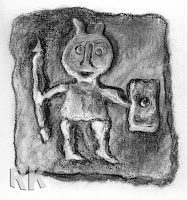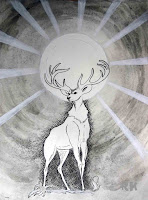
At Roman Bath, no trace of an antlered goddess survives, which is hardly surprising, given the potentially massively subversive effect that the depiction of an antlered and powerful sun goddess would have on the belief in masculine Sol, Roman state god of the sun. Instead what is shown is a monstrous moustachioed male sun-head disc, glowering down on all who approached Sulis’ thermal spring [Aquae Sulis], although the heavily sculpted eyes still mesmerise with their intensity, and the originally watery attribute of the native Sulis is hinted at by the serpentine forms around it, which alternate with sun rays, giving the modern ‘Gorgon’ reading of the piece.
Continuing the sun and water association, in Neolithic Ireland, perhaps a midwinter sun goddess may have been welcomed into Newgrange, where her winter sun rays struck stone bowls filled with sacred goddess water from the Boyne [i.e., Boande], no doubt sending mesmerising, dazzling reflections into the interior of the monument; the central water-filled bowl perhaps fulfilling a similar symbolic function to a mirror. There are numerous examples of folk belief concerning the rising sun reflected in wells and vessels of water 57. It is also no great surprise to read that “pieces of deers’ or stags’ or elks’ horns” were found inside the cave-like passageway monument of Newgrange, when it was explored in 1699 58. The motif of the sun within a cave is found throughout Eurasia. Michael Witzel has shown that cultural movement and communication across “the Eurasian steppe belt that stretched from Hungary and Rumania all the way to eastern Manturia”59 may be responsible for the consistent motifs of solar belief, here surveyed; the sun is invariably female in these myths, and they often concern its disappearance and restoration from cavernous interiors: the myths of the sun goddess Amaterasu, from Japan, and the dawn goddess Ushas from India, released from the Vala cave, are examples. 60
The effect of reflecting the sun from a mirror-like body of water into an interior setting would be to fill it with glittering light, which is exactly the type of effect that might be expected to be encountered, within a mythical sun palace. And this is just what we find in Elen’s fortress at Segontium, a “fine hall: its roof seemed all of gold … its doors all of gold. There were golden couches 61 …”, golden gaming pieces on silver boards, and occupants wearing golden jewellery and “red gold” embellishments; and the Celtic deer-women who personify sovereignty, ultimately all share a fabulous sunny aura of gold and fire: Elen, “a girl in a chair of red gold, and looking at the sun at its brightest would be no harder than looking at her beauty”62. Light can be depicted as a brightness, sometimes red or orange, frequently yellow or white, and there are consistent references to the colour white, hue of light, in Arthurian and related literature – a colour usually associated there with deer or courtly ladies, for example: Blancheflor (white flower), Helain the White (Vulgate Cycle), Elaine the White, mother of Launcelot; Elaine the White, or the Fair, enamoured of Lancelot; a white stag appears in the Arthurian ‘Gereint, Son of Erbin’ as well as Chretien’s ‘Eric and Enid’; a white antlered hind features in the Lais of Marie de France, a story with Arthurian parallels; and the fact that the text draws our attention to the fact that this female deer wears male “antlers of a stag on its head”63 is not without its symbolism.
Paganism in Ireland held its ground much longer than in England, Scotland and Wales, and one of the Arthurian myths which exemplifies the deer-sun-sovereignty motif is the 15th century ‘Visit of the Grey Ham’64, giving a remarkably terrific rendition of an Arthurian female, with perhaps more in common with the ancient Cailleach than with the courtly ladies more usually associated with the Knights of the Round Table. Suffice to say, the hunt of a shining deer reveals a glowingly golden maiden who ultimately weds King Arthur, revealing her ritual function as sovereignty. The name Grey Ham derives from her dual deer-woman nature, giving her supposedly tufts of grey fur on the backs of her legs; her actual name of Ailleann, is cognate with that of Ellen 65. It is suspected that pagan source-material re-entered Wales from Ireland and helped to form the mythic background from which both the Mabinogion and the Arthurian ‘Matter of Britain’ evolved. 66
Archaeology has provided material evidence for sun cults in Iron Age Celtic and Roman Britain, and continental Europe. Numerous ‘sun wheels’ have been recovered from ancient sites, notably springs, lakes, rivers and wells 67 – establishing the sun-water correspondence in the Celtic mind. A perhaps forerunner of the Grail, Ceridwen’s Cauldron, was kept ever broiling beneath the prodigious Llyn Bala by a well-fed fire, at the bottom of this vast lake. I wonder if the inspiration for this correspondence was partly water’s ability to reflect, giving an optical illusion of the two disparate elements – fire and water – as one? Archaeology has also provided evidence for the identification of Iron Age female deities with the sun, in the form of clay 'Venus figurines' decorated with sun wheels, concentric circles and other celestial symbols.

Sun goddess continuity - from the Neolithic to the Iron Age - is suggested in the form of the Bronze Age ritual sun disc, worn by the Egtved girl in Denmark, testifying to this apparently consistent tradition of female solar veneration 68. Is it also conceivable that the reindeer antler-carrying Abbots Bromley Horn Dancers have preserved a remote memory of a solar reindeer cult, which may have existed in Britain, some time between the ending of the last Ice Age and almost into the dawning of the modern era? In the Uralic mythology of the Saami people, reindeer were considered, to a great extent, to be animals of the sun, the sun goddess Biejvve, a deity also associated with white animals and the image of the eye, in northern Scandinavia. 69
Mythological goddesses of radiant light are a global phenomenon; they do not belong to any one, single system of belief. The glory of the “shining”, goddess-like ‘Shekhina’ 70 is integral to the ‘Tree of Life’ from the arboreal-structured Kabala of Judaic mysticism; whilst perhaps the mythical archetype from pre-diaspora Africa, the Karraru Australian Aboriginal sun goddess, 71 from one of the oldest religions on earth, may take us back to the very cradle of the human race? In medieval Europe, Roger Loomis has identified the Arthurian Elaine with the Grail-Bearing Maiden, 72 and I consider that in the name of Elaine we have a pre-Christian incarnation of the sun goddess, uplifting the golden solar vessel, which is itself a metaphor for the nurturing, beneficent sun.

Thus, the search for the holy grail is the hunt for the miraculous solar therioform – the quest for the glowing sun goddess, in her anthropomorphic shape as sovereignty; without whom no ruler could rule or land be ruled over. As sovereign goddess, it is appropriate that Elen is a deity of the ways, in that she could be seen to be constantly present, in all places, and at all times – far and near along the roads, paths, tracks and watercourses which criss-cross her demesne. However, until we can recognise Elen for what she symbolises, the light implicit in her name may remain hidden from us, like an elusive dryad, or vision of the sun maiden, in her megalithic mound, cave or otherworldly castle, awaiting her Macsen?
Notes
52. p.238, ‘eye’, T D Bhaldraithe, ‘English-Irish Dictionary’, 1987.
53. http://www.angelfire.com/rant/tgpedersen/swl.html
54. cf. n53. The IE root *swel- provides the basis for Selene (s+elene), but see http://www.mega.nu/protolanguage/proto-religion/apollo.htm
55. p.45, Michael Witzel, ‘Myth of the Hidden Sun’, http://209.85.229.132/search?q=cache:7Cot1yinZ5oJ:www.ejvs.laurasianacademy.com/ejvs1201/ejvs1201article.pdf+witzel+michael+sun&hl=en&ct=clnk&cd=1&gl=uk
57. p.98, n15, Janet McCrickard, ‘Eclipse of the Sun’, 1990; citing Danaher, 1972.
58. p.24, Michael J O’Kelly, ‘Newgrange’, (1982), 2004.
59. see p.60, Witzel, ibid.
60. p.2, Witzel, ibid.
61. p.120, Jeffrey Gantz (transl), ‘The Mabinogion’, 1976.
62. p.121, ibid.
63. p. 44, Glyn S. Burgess, ‘The Lais of Marie de France’, 1999
64. pp. 337-80, C P Hartnett, Irish Arthurian Literature, ‘The Visit of Gray-Ham’, 1973.
65. http://www3.sympatico.ca/lquirke/irishnames/gaeltachtgirls.html
66. p.25, Roger Loomis, ‘Celtic Myth and Arthurian Romance’, (1926), 1993.
67. p.144ff, Miranda Green, ‘The Wheel as Cult-Symbol in the Romano-Celtic World’, 1984.
68. see Anni Broegger’s, ‘Egtvedpigens Dans’, Forlaget Mammut Press, 2003.
69. pp.7, 12, Bergman et al (and Lundmark in) ‘Sami Use of Scots Pine’, Arctic Anthropology,
vol.41, No1, 2004.
70. pp. 105, 115-116, Raphael Patai, ‘The Hebrew Goddess’, (1967), 1990.
71. p.23ff, W Ramsay Smith, ‘Myths and Legends of the Australian Aborigines’, (1932), 2003.
72. p.157, Roger Loomis, ‘The Grail’, (1963), 1992.
*asterisk denotes hypothetical reconstruction.
Some related reading, where not indicated in the notes to text:
Terence Meaden, ‘Secrets of the Avebury Stones’, 1999.
Jamie Hall, ‘Half Human, Half Animal’, 2003.
Illustrations
1. 'Samhain', West Kennet Long Barrow from 'The Avebury Paintings'. Oil on canvas, Ric Kemp, 2008.
2. Iron Age 'Venus figurine'. Charcoal. After Blanchet, 'Étude sur les figurines en terre cuite', 1890.
3. The Grail Maiden, after Arthur Rackham in [Malory's] 'Romance of King Arthur', 1917.
© Ric Kemp, 2007-8



..jpg)

